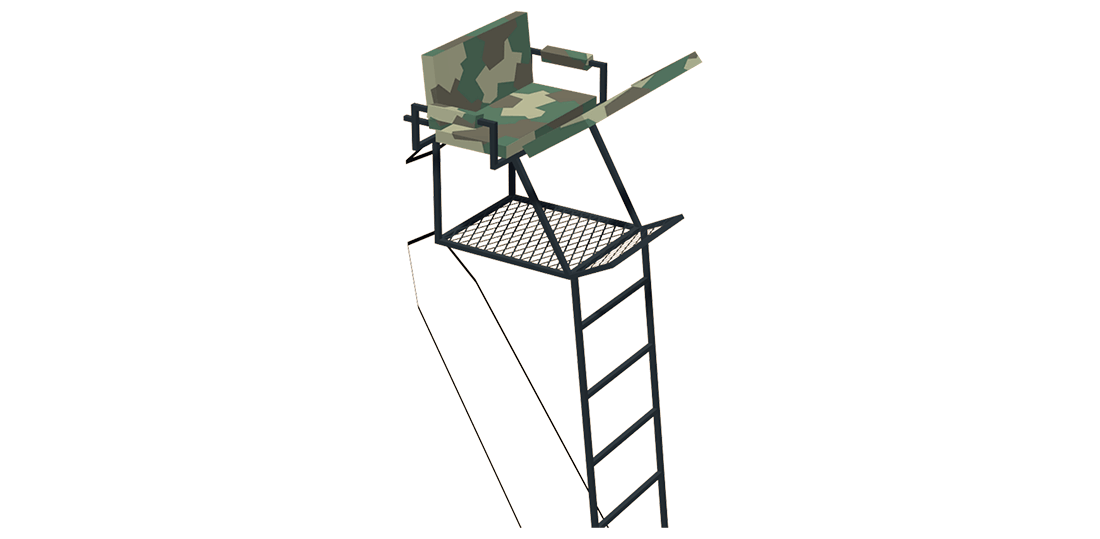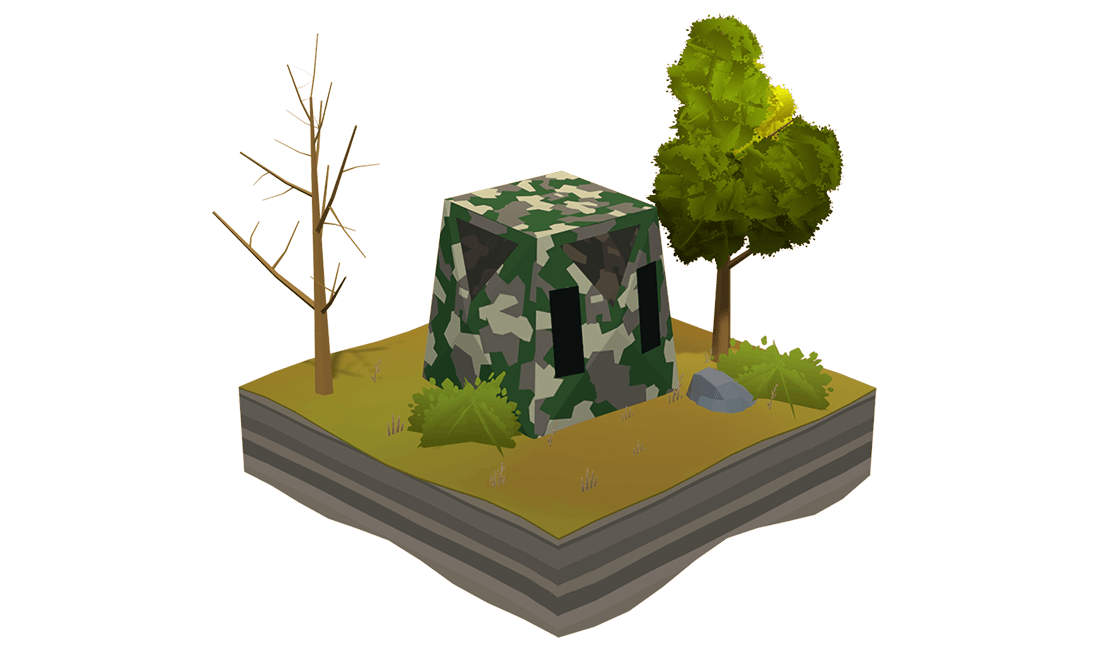Types of Elevated Stands Hang-On Stands - Climbing Stand - Ladder Stands

- Platform Stand
- Tripod Stand
- Hang-on Stand
- Climbing Stand
- Ladder Stand
Any stand should be thoroughly inspected for proper materials and construction. Only materials that will support the appropriate weight should be used. All welds, hardware and stress points should be inspected prior to each use for damage or deterioration.
Platform Stand

Platform stands come in multiple sizes and styles, and most are designed to accommodate more than one hunter.
Some purchase pre-manufactured shooting houses, others build their own. When erecting a pre-manufactured shooting house, be sure to read and follow the manufacturer's assembly instructions. If you are building your own, consider consulting a professional to be sure the design of your stand is safe.
Tripod Stand

Similar to a ladder stand, these stands are used alone without the need to be secured to a tree.
They are ideal for use in a field or in an area where there are no trees. For safety purposes it is important to set this stand up on a hard ground free of any slopes.
Hang-On Stands

Hang-on stands consist of a small platform attached to a seat. The stand is attached to the tree using straps and cables or chains.
Hunters using a Hang-on stand must choose a way to climb up to and down from the platform. The safest and most commonly used methods are sectional ladders.
Sectional ladders are usually manufactured in lengths of three or four feet and joined together to allow the hunter to reach the desired height. They are secured to the tree with ratcheting devices or chains limiting tree damage. Always check every ladder section connection every time you use the ladder, before you leave the ground. If any ladder sections are separating, do not use the ladder.
When using a fixed position or hang-on stand, practice attaching the stand at ground level before using it in a hunting environment.
Stay connected to the tree from the time you leave the ground until you are back down. Use a haul line to raise and lower the stand.
Chains, cables, and straps must be adjusted and tightened properly to provide a secure, stable stand position. All stand contact points must be in contact with the tree before you step onto your stand.
Sectional ladders should be spaced on the tree, so each step is no more than 18 inches apart. Climbing aids must extend above the seating platform to allow you to climb above the stand and step down onto the center of the standing platform. Never step up to your stand from a climbing aid.
Never rely on a tree branch or limb for support. They can break and cause you to sustain injuries as a result of falling. Never use wood steps attached to the tree with nails or spikes.
Screw-in steps are dangerous to the hunter and damage the tree. They should not be used.
Climbing Stands

Climbing stands consist of two pieces – the seating and standing platforms. Hunters climb the tree by moving the seating platform with their upper body, securing it to the tree, then lifting the standing platform with their feet, and securing it to the tree, until they are at the desired height.
Always read and follow the manufacturer's instructions.
Before using a climbing type stand, connect both the seating and standing platforms together to prevent them from separating. Use the connecting method and all safety devices provided by the manufacturer.
To compensate for the narrowing of the tree trunk as you go up, attach both platforms at ground level to the tree in a slightly upward direction. As the climber goes up the tree, the platform will begin to level. If the lower (standing) platform begins to slope downward or away from the tree, you must return to the ground to make adjustments
Never hurry! Only move one platform a short distance. Make sure the platform you move is secure and stable before moving the other platform.
Ladder Stands

Ladder stands include a ladder and platform that can be secured to a tree.
Each section of a ladder should be held together with retainer pins, clips, bolts or some other device provided by the manufacturer to prevent the ladder sections from coming apart unexpectedly. Check every ladder section connection every time you leave the ground. If ladder sections are separating, do not use the stand.
The ground under a ladder stand should be firm and level. Sloping ground or an uneven surface can cause the ladder to tilt or shift off the tree as you climb. When installing a ladder stand, always bounce on the first rung to set the ladder into the ground according to the manufacturer's instructions before proceeding to climb any higher.
Ladder stands require at least three people to install or remove as outlined in the manufacturer's instructions. Do not risk your safety or the safety of others by attempting to install or remove it yourself.
The crisscross straps and stabilization devices should be attached to the tree before climbing to the platform.
ALWAYS lean forward and maintain three points of contact while climbing the ladder. Example: two hands and one foot.
Use a haul line to raise or lower all equipment from the ground to your stand once you are in the stand and secured to the tree with your Fall Arrest System or Full Body Safety Harness.
Ground Blind

Ground blind is a structure consisting of a frame and a top that is placed on the ground to completely enclose a hunter while hunting deer. Ground blinds have become a great alternative to that of hunting from an elevated stand. Blinds can accommodate multiple hunters and their equipment. Using a ground blind also eliminates the dangers of falling.
Hunting from a blind still requires hunters safety when we enter the blind
- Firearms should be unloaded when entering and exiting a blind with the muzzle pointed in a safe direction.
- When hunting alone, a hunter can lay the firearm down near the blind, get into the blind and then retrieve the firearm.
- When hunting with a friend, the unloaded firearm can be handed to the friend while entering the blind. The hunter inside the blind can then be handed the firearms and safely put them inside the blind. It is only then that the other hunter may enter the blind.